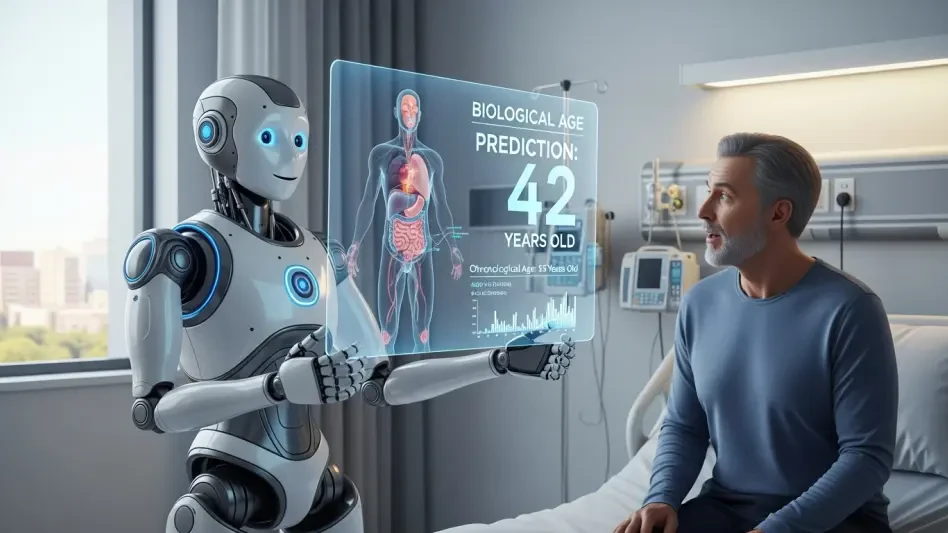In an era where healthcare is increasingly driven by data, a staggering reality emerges: chronological age often fails to reflect an individual’s true health status, leaving critical gaps in personalized medical strategies that could save lives. This discrepancy has fueled a technological revolution, with artificial intelligence (AI) stepping in to predict biological age—a more accurate marker of overall well-being. At the forefront of this innovation is a pioneering collaboration between Seoul National University Hospital (SNUH) and Naver, a leading internet conglomerate, which has developed a cutting-edge AI model to transform health risk assessment. This technology promises to redefine how medical professionals approach disease prevention and patient care, paving the way for a new frontier in precision medicine.
Unveiling the SNUH-Naver AI Model
The collaboration between SNUH and Naver has resulted in a transformative AI tool designed to calculate biological age and predict health risks with unprecedented detail. Built on a transformer-based deep learning framework, this model analyzes vast amounts of medical data to provide insights that go beyond traditional health metrics. Its development marks a significant leap in digital healthcare, offering a glimpse into how technology can bridge the gap between raw data and actionable medical advice.
What sets this model apart is its foundation on an extensive dataset, drawn from health checkups of 151,281 individuals at SNUH Gangnam Center over nearly two decades. This rich repository includes body measurements, lab results like blood sugar and cholesterol levels, and even mortality records. By categorizing patients into normal, pre-disease, and disease groups, the AI tailors its predictions to reflect nuanced health states, ensuring relevance across diverse populations.
To account for physiological variations, the model employs separate frameworks for men and women, enhancing its precision. This gender-specific approach allows for a deeper understanding of how health indicators manifest differently, providing a more detailed perspective on biological age. Such customization underscores the potential of AI to deliver highly individualized health insights, a cornerstone of modern medical advancements.
Performance and Key Insights
The effectiveness of the SNUH-Naver AI model shines through in its ability to distinguish between health groups based on biological age discrepancies. Findings published in a prominent medical journal reveal that individuals in the normal group often have a biological age lower than their chronological age, signaling robust health. Conversely, those in the disease group display a higher biological age, reflecting underlying medical challenges.
A critical observation from the analysis is the correlation between the gap in biological versus chronological age and deteriorating health markers. Wider disparities are linked to elevated risks, such as cardiovascular issues or cancer, and even higher mortality rates. This insight provides a powerful tool for clinicians to identify at-risk patients early and prioritize interventions accordingly.
Further bolstering its credibility, the model incorporates Kaplan-Meier survival analysis to stratify individuals into healthy, reference, and unhealthy categories. Results consistently show lower survival rates among the unhealthy group across genders, emphasizing the predictive power of biological age as a health indicator. This data-driven approach offers a stark improvement over conventional methods that often overlook long-term outcomes.
Innovations Setting New Standards
A standout feature of this AI model is its status as the first transformer-based tool to integrate disease prevalence and mortality risk into biological age calculations. Unlike traditional frameworks, such as the Klemera and Doubal method, which struggle to account for chronic conditions or future health trajectories, this innovation provides a holistic view. It captures the complexity of health dynamics in a way that older models simply cannot match.
Globally, parallel efforts echo this trend toward AI-driven health prediction. In Singapore, researchers have developed algorithm-based models using clinical data and retinal scans to forecast long-term health outcomes over extended periods. These initiatives highlight a shared recognition of AI’s potential to interpret intricate medical data, ultimately refining patient care strategies on a worldwide scale.
The SNUH-Naver model’s ability to blend diverse health indicators into a cohesive prediction framework positions it as a leader in the field. Its sophisticated methodology not only enhances diagnostic accuracy but also opens doors to preventive measures tailored to individual needs. This marks a pivotal shift in how technology can inform healthcare delivery with precision and foresight.
Real-World Impact on Healthcare Systems
The practical applications of this AI technology in healthcare are vast and promising. By providing a clear picture of biological age, the model enables medical professionals to craft personalized health management plans that address specific risks before they escalate. This proactive stance could significantly reduce the burden of chronic diseases on both patients and systems.
Beyond individual care, the tool offers value in optimizing resource allocation within healthcare facilities. By identifying high-risk individuals through data-driven predictions, providers can prioritize interventions and allocate resources more efficiently. Such capabilities are especially critical in environments where medical resources are stretched thin, ensuring that attention is directed where it is most needed.
Unique use cases further illustrate the model’s versatility, such as its potential to guide public health initiatives. Governments and institutions could leverage these insights to design targeted prevention campaigns, addressing prevalent health issues at a community level. This broader application underscores the transformative impact of AI in shaping not just personal, but societal health outcomes.
Challenges in Implementation
Despite its groundbreaking potential, deploying the SNUH-Naver AI model comes with notable hurdles. Technical challenges, including concerns over data privacy, loom large, as the handling of sensitive medical information demands stringent safeguards. Ensuring compliance with global data protection standards remains a critical priority for widespread adoption.
Regulatory obstacles also pose significant barriers, as the integration of AI in healthcare requires standardized guidelines to govern ethical use. Without clear frameworks, the risk of misuse or misinterpretation of predictions could undermine trust in such technologies. Addressing these concerns will be essential to gaining acceptance from both medical communities and regulatory bodies.
Efforts to refine the model are ongoing, with a focus on improving scalability and accessibility across diverse populations. Transformer-based systems, while powerful, can be resource-intensive, necessitating innovations to make them viable for smaller healthcare settings. Overcoming these limitations will be key to ensuring that the benefits of this technology reach a global audience.
Looking Ahead: The Future of AI in Health Prediction
The horizon for AI-driven biological age prediction is brimming with possibilities, particularly with the integration of emerging technologies like wearable health devices. Combining real-time data from such tools with sophisticated AI models could further enhance prediction accuracy, offering a dynamic view of health status as it evolves. This synergy holds immense promise for preventive medicine.
Future breakthroughs may also expand the scope of applications, potentially incorporating genetic data or environmental factors into predictions. Such advancements would provide an even more comprehensive understanding of biological age, enabling interventions that are not just reactive but truly anticipatory. The trajectory of this field points toward increasingly personalized healthcare solutions.
The long-term impact on healthcare systems could be profound, fostering a shift from treatment-focused models to proactive health strategies. As AI tools like the SNUH-Naver model become more refined, they are likely to play a central role in improving patient outcomes and reducing costs. This evolution signals a fundamental change in how health and wellness are approached on a systemic level.
Final Reflections
Looking back, the development of the SNUH-Naver AI model stood as a landmark achievement in the realm of personalized medicine, demonstrating the power of transformer-based technology to decode complex health data. Its nuanced approach to biological age prediction offered a fresh perspective on risk assessment, surpassing the capabilities of traditional methods. The insights it provided into survival rates and disease prevalence marked a turning point in data-driven healthcare.
Moving forward, stakeholders should focus on addressing the technical and regulatory challenges that hinder broader implementation. Collaborative efforts between tech innovators, healthcare providers, and policymakers will be crucial to establish robust frameworks for ethical AI use. Investing in scalable solutions to make such tools accessible across varied settings emerges as a priority.
Additionally, fostering public awareness about the benefits and limitations of AI in health prediction becomes essential to build trust and encourage adoption. By prioritizing interdisciplinary partnerships and continuous refinement, the medical community can harness this technology to not only predict but prevent health crises, ultimately shaping a healthier future for all.









